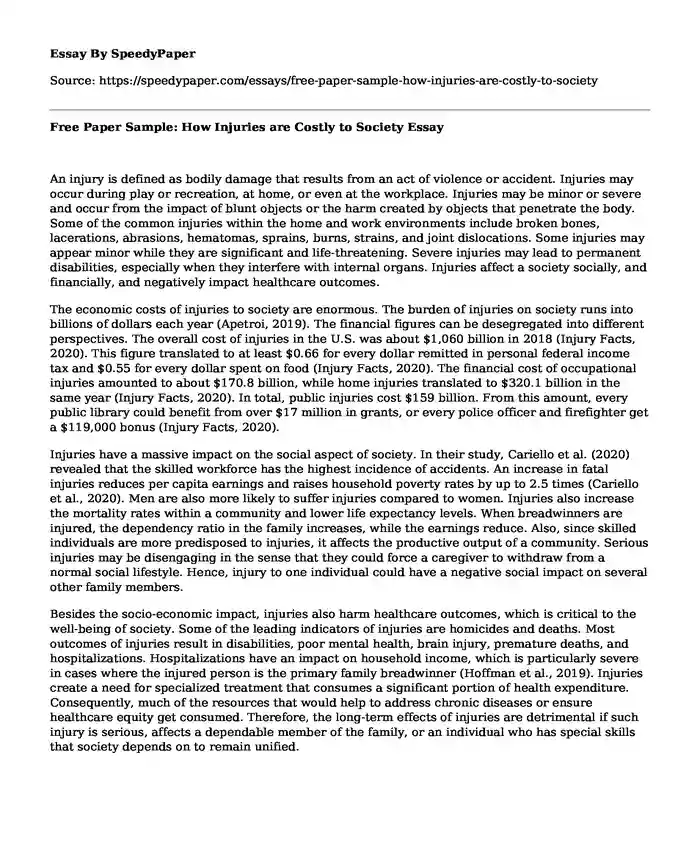
| Type of paper: | Essay |
| Categories: | Health and Social Care Economics Society |
| Pages: | 3 |
| Wordcount: | 739 words |
An injury is defined as bodily damage that results from an act of violence or accident. Injuries may occur during play or recreation, at home, or even at the workplace. Injuries may be minor or severe and occur from the impact of blunt objects or the harm created by objects that penetrate the body. Some of the common injuries within the home and work environments include broken bones, lacerations, abrasions, hematomas, sprains, burns, strains, and joint dislocations. Some injuries may appear minor while they are significant and life-threatening. Severe injuries may lead to permanent disabilities, especially when they interfere with internal organs. Injuries affect a society socially, and financially, and negatively impact healthcare outcomes.
The economic costs of injuries to society are enormous. The burden of injuries on society runs into billions of dollars each year (Apetroi, 2019). The financial figures can be desegregated into different perspectives. The overall cost of injuries in the U.S. was about $1,060 billion in 2018 (Injury Facts, 2020). This figure translated to at least $0.66 for every dollar remitted in personal federal income tax and $0.55 for every dollar spent on food (Injury Facts, 2020). The financial cost of occupational injuries amounted to about $170.8 billion, while home injuries translated to $320.1 billion in the same year (Injury Facts, 2020). In total, public injuries cost $159 billion. From this amount, every public library could benefit from over $17 million in grants, or every police officer and firefighter get a $119,000 bonus (Injury Facts, 2020).
Injuries have a massive impact on the social aspect of society. In their study, Cariello et al. (2020) revealed that the skilled workforce has the highest incidence of accidents. An increase in fatal injuries reduces per capita earnings and raises household poverty rates by up to 2.5 times (Cariello et al., 2020). Men are also more likely to suffer injuries compared to women. Injuries also increase the mortality rates within a community and lower life expectancy levels. When breadwinners are injured, the dependency ratio in the family increases, while the earnings reduce. Also, since skilled individuals are more predisposed to injuries, it affects the productive output of a community. Serious injuries may be disengaging in the sense that they could force a caregiver to withdraw from a normal social lifestyle. Hence, injury to one individual could have a negative social impact on several other family members.
Besides the socio-economic impact, injuries also harm healthcare outcomes, which is critical to the well-being of society. Some of the leading indicators of injuries are homicides and deaths. Most outcomes of injuries result in disabilities, poor mental health, brain injury, premature deaths, and hospitalizations. Hospitalizations have an impact on household income, which is particularly severe in cases where the injured person is the primary family breadwinner (Hoffman et al., 2019). Injuries create a need for specialized treatment that consumes a significant portion of health expenditure. Consequently, much of the resources that would help to address chronic diseases or ensure healthcare equity get consumed. Therefore, the long-term effects of injuries are detrimental if such injury is serious, affects a dependable member of the family, or an individual who has special skills that society depends on to remain unified.
Conclusion
In conclusion, injuries vary in severity and affect different aspects of society. Injuries have substantial financial impacts as the cost of treating physical and mental disabilities is enormous, and harms productive capacity when skilled individuals suffer. Individuals who suffer from injuries have to rely on family members for assistance and spend a significant portion of their earnings on medication. Serious injuries may be fatal, in which case they may also lead to deaths. Hence, the lower the life expectancy of the society. Socially, such losses deny spouses and children the joy of parenthood, which may hurt them in the long term.
References
Apetroi, F. C. (2019). The economic effects of work-related injuries and occupational diseases. http://irek.ase.md/jspui/bitstream/1234567890/179/1/Apetroi-F-C_conf_09.19_teze.pdf
Injury Facts. (2020). Societal Costs - Injury Facts. Retrieved 10 September 2020, from https://injuryfacts.nsc.org/all-injuries/costs/societal-costs/
Cariello, A. N., Tyler, C. M., Perrin, P. B., Jackson, B., Librandi, H., Sutter, M., ... & Feldman, M. J. (2020). Influence of social support on the relation between stigma and mental health in individuals with burn injuries. Stigma and Health. https://psycnet.apa.org/doi/10.1037/sah0000250
Hoffman, G. J., Liu, H., Alexander, N. B., Tinetti, M., Braun, T. M., & Min, L. C. (2019). Posthospital fall injuries and 30-day readmissions in adults 65 years and older. JAMA network open, 2(5), e194276-e194276. doi:10.1001/jamanetworkopen.2019.4276
Cite this page
Free Paper Sample: How Injuries are Costly to Society. (2023, Dec 07). Retrieved from https://speedypaper.com/essays/free-paper-sample-how-injuries-are-costly-to-society
Request Removal
If you are the original author of this essay and no longer wish to have it published on the SpeedyPaper website, please click below to request its removal:
- Essay Example on Cystic Fibrosis
- Free Essay on Vulnerable Populations in Healthcare
- Paper Example. Abuse in the Shining
- Essay Sample on The Dilemma of Jehovah's Witness Children Who Need Blood to Survive
- Technology Revolutionizing Healthcare: Electronic Health Records - Essay Sample
- Free Essay: Effects of Food Preferences
- Unraveling COVID-19: A Comprehensive Case Study on its Origins, Global Impact, and Strategies for Recovery
Popular categories




